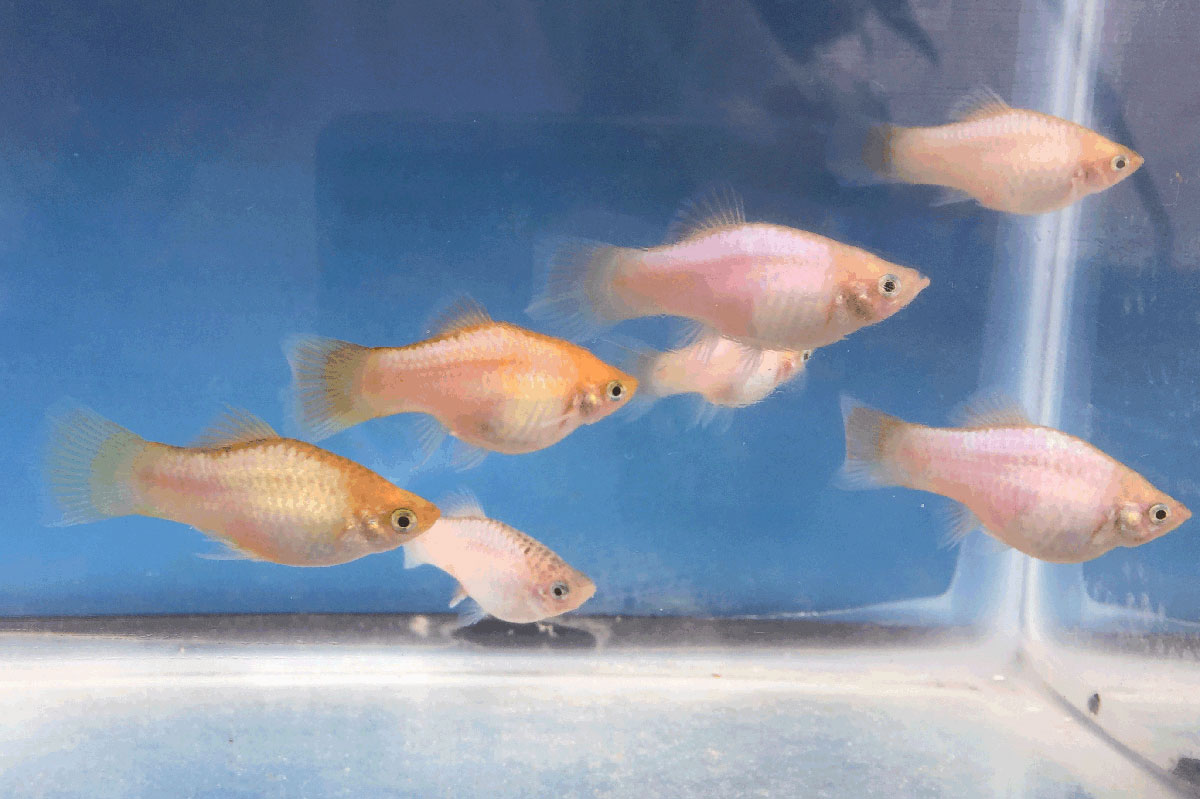Photo: A group of Blue Opal Maculatus
Years ago I created what I called a Hifin Blue Opal Maculatus, as its name implies a maculatus-type platy. I wrote about creating this fish for Tropical Fish Hobbyist. To read the TFH article see: http://www.tfhmagazine.com/details/articles/the-blue-opal-platy-serendipity-in-breeding.htm. I’ll provide a synopsis of the development of this fish below.
Long ago in 2007 I wanted to add the hifin characteristic to our platy strains. I acquired some mixed hifin platies and sorted them into fish that resembled the strains we had. Two males were similar to our Neon Marigold Maculatus. I gave these two males some of our Neon Marigold Maculatus and selected the resulting hifin offspring that looked most like neon marigolds. These fish were mated together and when their offspring were sorted I discovered a half dozen pale blue fish on a gold background. I dubbed these Blue Opal Maculatus. These six fish were set up for breeding and I soon had a nice strain of Blue Opal and Hifin Blue Opal Maculatus. Despite selecting only hifin breeders this strain continues to throw about one-third non-hifins. The reason for this 2:1 ration of hifins to non-hifins is discussed in detail in an earlier blog (http://goliadfarms.com/freckle-hifin-genetic-tests/).
I also had plumetail platies. For a discussion of the plumetail mutation see and article I wrote for TFH http://www.tfhmagazine.com/details/articles/the-tail-of-two-platies.htm. Plumetail is a dominant mutation (allele) causing the center of the caudal (tail fin) to be elongated. Unlike the hifin mutation, plumetail is not a homozygous lethal so it is possible to develop a strain breeding true for this characteristic. If you read the blue opal article at TFH you understood the preceding statement. If not, you should read it. In any event, a while back I decided to add plumetail to our Blue Opals.
The process to create a Hifin Plumetail Blue Opal Platy started over a year ago. To add plumetail to this strain I sorted through a vat of miscellaneous plumetails we keep just for this purpose and found a male that sort of matched our Blue Opal Maculatus. I gave that male a number of our Hifin Blue Opal Maculatus females. The resulting offspring were a motley group of colors. From them I picked a plumetail male most closely resembling Blue Opals and gave him a batch of Hifin Blue Opals. This happened one more time; the best plumetail male (meaning looked like a Blue Opal) was again mated to Hifin Blue Opal females. We recently processed the offspring resulting from this last mating. The mating yielded some reasonably good Hifin Blue Opals and some reasonably good Plumetail Blue Opals. There were some not so good Hifin Plumetails; bad color and not so great fins. The Hifin Blue Opals and Plumetail Blue Opals have been set up together for breeding. Since both groups have nice clear Blue Opal coloration (due to a pair of recessive genes, I think anyway), I expect they’ll breed true for color and I should get some nice Hifin Plumetail Blue Opals next generation. To speed this along I selected only hifin females and plumetail males. The reason for this will become clear below.
For genetics freaks let’s discuss these crosses in a bit more detail.
First, I want to make a statement about photography. My photography, despite having a decent digital SLR camera sucks. Part of the reason for this is the conditions I under which I take photos. I don’t find I have time to set up permanent photography tank. There just aren’t enough hours in the day to maintain it. So, I tend to photograph the fish where I work, in the greenhouses in bare tanks with fish that have just been jerked from their homes. One problem with taking pictures in the greenhouses is the air is often warmer than the water and the humidity is 100%. As a result, the tank fogs over immediately (as does the lens on the camera or the iPhone) and I have to keep wiping them off, snapping a couple of photos, wiping again, etc. (ad infinitum would be more appropriate). One final note, Carl (our son and new business partner) took the good photos with his iPhone. I’m responsible for the bad ones.
Let’s start with a couple of photos of the Blue Opal Maculatus strain. The first is a female hifin of the strain, showing my favorite color type. I’ll discuss the other color types of this strain below.

Next, is a photo of a couple of non-hifin females, again of my preferred color type.

Now, here’s a Plumetail Blue Opal, also of the preferred color type, except she shows a bit of red in the fins, a characteristic from her great grandfather. A bad photo, but what can I say. Photography sucks.

I’ve yet to get a good color type Hifin Plumetail (I will next generation remember), but here’s a young Hifin Plumetail with really bad color. He not only has bad color but doesn’t have a good plumetail or hifin. He is young so maybe his hifin will improve with age.

The photo below shows the two color morphs we have in our current population of Blue Opals. I don’t like the gold background of the two fish to the left and select against it. The percentage of gold fish declines each generation and should disappear at some point. If I were obsessive-complusive about this I’d raise virgin females (the females store sperm from earlier matings, so if you want to be absolutely certain about male parentage you have to start with virgin females) and do the matings necessary to understand the underlying color genetics. I’m lazy and simply cull and sell the gold fish.

The next photo shows the range of colors and the fin types we got in this last generation. There are four fin types, non-hifin/non-plumetail, hifin, plumetails, and hifin/plumetails. There are basically three color types, including orangey, blue opal, and blue opal on gold background. The orangey fish are color culls. They inherited some of the colors from the original plumetail male I used. The ones that match my “preferred” types and the fish with goldish background color both appear in our current strain.

So, what do I expect in the next generation? First to make this a bit clearer let’s use the geneticist’s Punnett square and some graphics to illustrate the mating male Plumetail Blue Opals to female Hifin Blue Opals. The Punnett square (named after its inventor) is a grid used to predict the results of a cross. A Punnett square sets forth the gametes (eggs and sperm) produced by the two breeders and the offspring types resulting from the sperm fertilizing the eggs. I’m going to simplify this and assume that the males are heterozygous for plumetail and homozygous for non-hifin. We know the females are heterozygous for hifin and homozygous for non-plumetail. This Punnett square will have four cells because each parent will produce two types of gametes. These gametes will randomly combine to form four genetic types (genotypes) and four types of fish (phenotypes) in a 1:1:1:1 ratio. I’ve used “Pt” to represent the dominant allele for plumetail; its recessive is the normal tail (caudal) represented by “c”. And I’ve used “Hf” to represent the dominant hifin allele and “d” for the recessive normal dorsal. By the way, since I don’t have a nice Hifin Plumetail Blue Opal photo since one doesn’t exist yet, I’m using the bad colored young hifin plumetail male’s photo as a place-holder. Imagine a better fish there. Also, imagine the fish on the left is a male.
If the plumetail male was homozygous for plumetail then the offspring would be hifin plumetails and non-hifin/plumetails in a 1:1 ratio. The Punnett square would look like the one below. Again, imagine the fish on the left is a male and that the hifin plumetails are good fish instead of the lousy one in the photo.

Once I have some good Hifin Plumetail Blue Opals, I’ll select only those fish for breeding. Here’s a Punnett square showing those results assuming the fish all all homozygous for plumetail. The bright red DOA represents the embryos that are homozygous for hifin; remember hifin is a homozygous lethal. As a result of the loss of one-quarter of the embryos, the ratio of will be 2:1 hifin/plumetails to non-hifin/plumetails. This should make Susie happy since plumetails and hifin/plumetails bring more money than non-hifin/non-plumetails. Of course, the way things work out, everyone will want the latter fish…

Now, you may have noticed the plumetails don’t have great big bushy plumes (also called brushy tails by some). It is possible to select for bushiness, simply using the bushiest fish each generation. There is apparently a number of modifying genes (probably including branching, number of fin rays, etc.) that go into improving this characteristic. Here’s what that improvement looks like in another plumetail color strain.

The interesting thing is the above fish is a descendant of this fish:

The fish immediately above is an F1 offspring resulting from a mating I did after acquiring two very nondescript male plumetails. These two males were mated with Redwag Maculatus females. This male was then mated back to Redwag Maculatus females as was his son, grandson, and great grandson, finally resulting in Plumetail Redwag Maculatus. A few more generations of selecting for better and better coloration and plumetails led to the male Plumetail Redwag Maculatus above. For details about this set of matings, read the TFH article about plumetails mentioned earlier.
The same process can apply to the hifin characteristic. Diligent selection can lead to wider, longer, larger hifins by accumulation of modifier genes.
Genetics can be fun and useful’ Good fishkeeping!



Sebastian luna says
Bro ayúdame también estoy criando platys hifin
Charles Clapsaddle says
Sebastian, First, sorry for the late reply. Your message just appeared. How can I help you. The best way to reach me is via email at charles@goliadfarms.com.
Charles